Follow along with another instalment on the Egyptian highlights as Dale from The Maritime Explorer recounts a recent tour of Egypt led by us. In 2017 we were pleased to travel with Dale, a lawyer and travel writer from Canada. After returning from the tour, he shared with us his impressions of his Egypt tour and we are excited to share with you his beautiful photos and words. This post originally appeared on The Maritime Explorer and has been republished with permission.
At Adventures Abroad, we believe our travellers are the best group out there. Our small group tours are complemented by people with an adventurous spirit from all over the world. People who are keen to experience new cultures, peoples, cuisines, philosophies, and points of view.
Earlier this year Alison and I had the good fortune to travel to Egypt with Canadian travel company Adventures Abroad, fulfilling a lifelong dream for both of us. Thanks to veteran tour leader Martin Charlton and our Egyptian guide Ahmed Mohsin Hashem, our small group had an incredibly diverse experience that included not only the archaeological highlights of Egypt, but the cultural and gastronomic side of Egyptian society as well. So far I’ve written posts on Abu Simbel and the fabulous Mena House Hotel where we stayed before joining the tour (although we did have lunch there with the group on the day we visited the Pyramids). I also provided some useful tips on getting the most out of A Visit To The Pyramids And Sphinx. This post is about the Philae Temples complex just south of Aswan and after reading it I hope to have convinced you that it is a must see destination in Egypt.
What are the Philae Temples?
Philae (pronounced fy-lee), despite appearing to be Greek, is apparently a corruption of the Egyptian word pilak and is the name given to an island in the Nile that lies between the two dams at Aswan. Before coming to Aswan I had no idea that there are actually two dams here and not just the famous one built by the Russians in the 1970’s. The fact is between 1898 and 1902 the British built what was then the Largest Dam Ever Built at the site of the First Cataract of the Nile. If you look at this map you can see a road crossing the Nile at the top of the map. That is the old or low dam. Behind the dam is the island of Philae.
Philae has been a site of ancient veneration for thousands of years, associated with both Osiris and his sister/wife Isis. Some priests claimed that not only was Philae the burial place of Osiris. but also the first piece of land on earth. Despite the oxymoronic implications of a dead god, Philae became a place of worship and pilgrimage and by the time the Romans arrived in Egypt it was all but covered in temples.
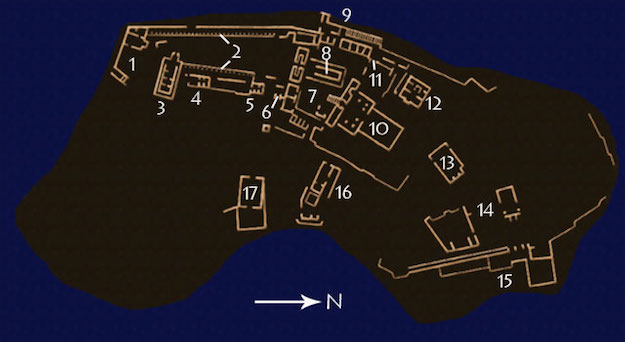 Plan showing the layout of the Philae Temples on Philae Island.
Plan showing the layout of the Philae Temples on Philae Island.
The building of the low dam resulted in semi-annual flooding that partially covered what remained of the temples for months of the year. Appreciating the damage this would do to the Philae Temples, the British did do enough underpinning to ensure that they did not get eroded away by the constant rise and fall of the Nile waters. What they couldn’t stop was the washing away of what were apparently among the brightest and best preserved of all Egytian temple paintings.
This is a recurring theme with the Philae Temples. Over hundreds of years, ancient Egyptians, Greeks and Romans strove to build mighty edifices to the gods they believed to be real. Over thousands more, forces of nature, religious fanaticism and the ‘march of progress’ allied themselves against the buildings and brought about their near destruction. Fortunately for future generations, there appears to be a truce and the Philae Temples, or what remains of them, are safe for the time being. Here’s how that came about.
If you look at the map again you will see a second line crossing the Nile near the bottom – that is the Aswan High Dam. Its builders were aware that when it was completed and Lake Nasser filled up behind it that when those water were released downstream, that would be the end of the Philae Temples, unless they were moved to high ground. And thanks to UNESCO and the efforts of many nations, they mostly were.
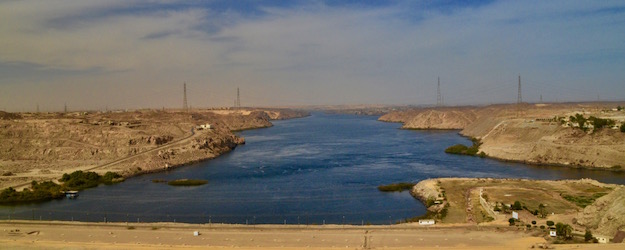 A view from below the Aswan High Dam on the Nile River.
A view from below the Aswan High Dam on the Nile River.
The Temple of Isis and the Kiosk of Trajan were taken apart block by block and moved to higher ground on the much smaller Agilikia Island which is where we are headed shortly.
So that’s the background of the Philae Temples and here are the reasons why you will want to be sure to visit them.
The Philae Temples Can Only Be Reached By Boat
During our trip to Egypt we spent a lot of time on the Nile and whether it be on a Nile cruise, on a felucca or simply on a small motor cruiser we enjoyed every minute of it. To get to Agilikia Island you get on a small covered boat with a usually very tiny outboard and motor up the river to the landing in a leisurely fashion that allows for sightseeing along the way.
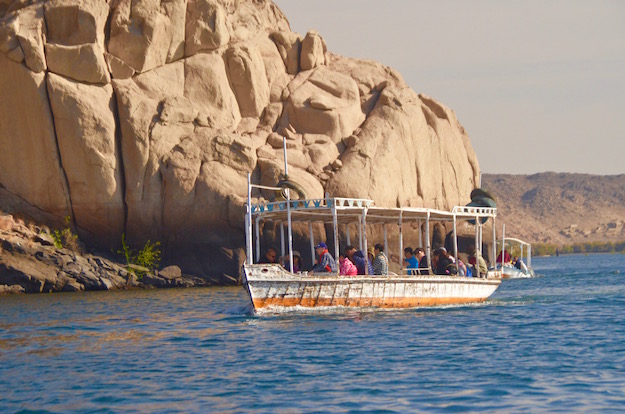 This is the typical boat you'll take to Philae Island.
This is the typical boat you'll take to Philae Island.
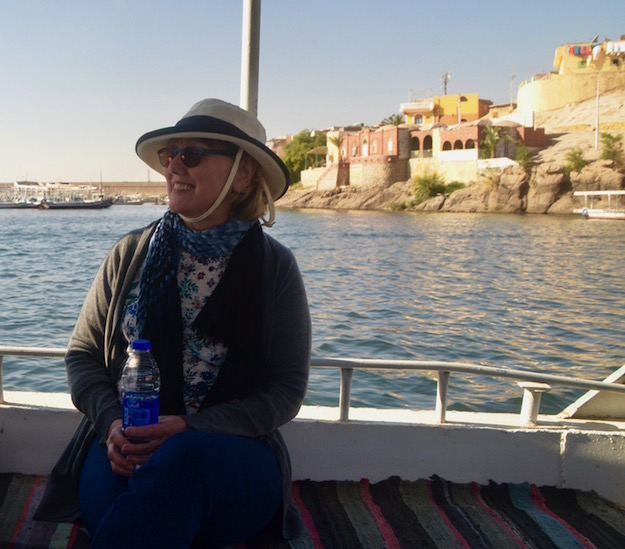 Alison enjoying the views of the Temple of Isis
Alison enjoying the views of the Temple of Isis
As you approach the island you past directly by the Temple of Isis which looks amazing from the water. You can clearly see the two sets of pylons that mark the entrance to the outer and inner portions of the temple. I must say that, for me, this was one of the highlights of the entire trip. It was the first relatively intact Egyptian temple we visited and just the sight of it set against the clear blue sky got my heart racing. I had to pinch myself and think, “Yes, you are really on the Nile River looking at the Temple of Isis at Philae and soon you’ll be in it.”
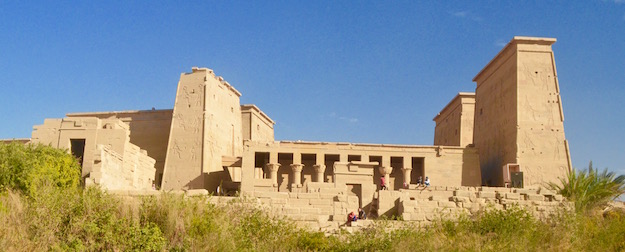 The Temple of Isis, as seen from the Nile River.
The Temple of Isis, as seen from the Nile River.
The Philae Temples are not Overrun by Aggressive Hawkers
One of the banes of visiting famous Egyptian monuments is running the gauntlet of aggressive vendors, hawkers, grifters, faux guides and outright lying charlatans that bedevil every place you might want to see. They are here at the Philae Temples, but not nearly in the numbers you’ll find at most other places. Also, they are mostly confined to the landing area and you can tour the complex with or without a guide, in relative peace.
The Philae Temples are not Overrun with Other Tourists
You would think that the almost complete collapse of the North American and European market for Egypt would mean that places like the Pyramids or the Temple of Luxor would be less crowded. Not so. The Asian market has exploded in recent years and has largely made up for the loss of western visitors. Also remember that Egypt has over 90 million souls and most can’t afford to vacation outside their country so they visit places within Egypt. The bottom line is that you have to be prepared to share your Egyptian experiences with a lot of other people, but not always. The Philae Temples, probably due to their relatively remote location, are one of the exceptions.
This is not exactly a huge crowd.
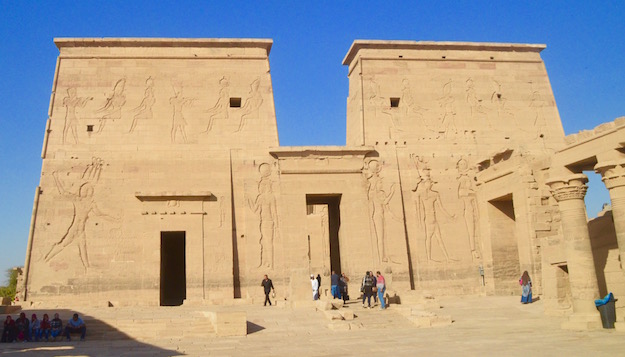 This view of the entrance to the Temple of Isis gives you a good idea of its scale.
This view of the entrance to the Temple of Isis gives you a good idea of its scale.
It’s always great when you can get a shot that makes it seem like you were the only ones there.
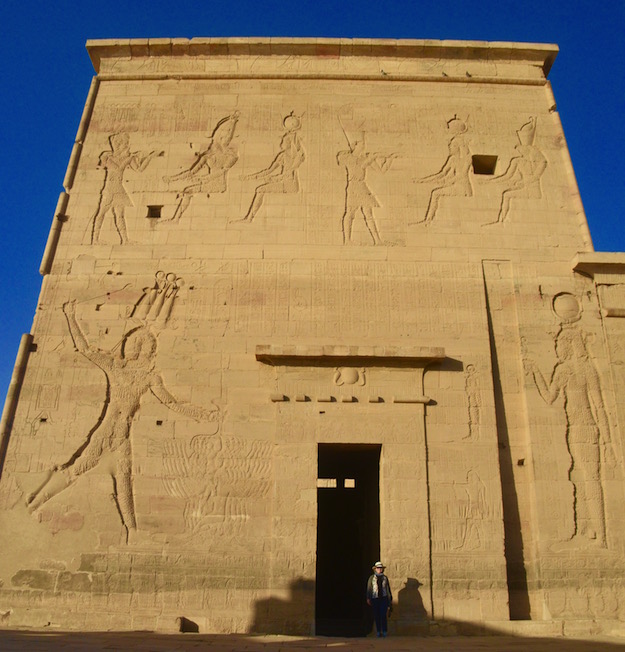 Alison at the entrance to the Temple of Isis.
Alison at the entrance to the Temple of Isis.
The Philae Temples are Very Well Preserved
When you think of Egyptian monuments like the pyramids, sphinx or Temple of Luxor you think ‘old – very, very old’ and you’d be correct. The first pyramids were built an astonishing 4,600 years ago. However, the span of Egyptian history is so long that something like the Philae Temples that seem ancient to us is actually, by Egyptian standards, a relative infant. The structures that comprise the Philae Temples were mostly built during the very last of the Egyptian dynasties, the Ptolemys who were actually Greeks, descendants of one of Alexander’s generals who divided up his kingdom after his death. Other building continued during the Roman period with additions like Hadrian’s gate. Thus, these temples are ‘only’ about 2,000 years old which may well explain why they have survived as well as they have.
The Temple of Isis is Wonderful
Even though the Temple of Isis is at least a thousand years younger than more famous temples like Luxor and Abydos, it still follows a classic pattern of Egyptian temples that survived for millennia. It is the perfect place to be instructed on Egyptian temple design by a knowledgable guide such as Ahmed, who is not only familiar with all the Egyptian myths and legends, but can read hieroglyphics as well. What looks to me like just some carvings of gods and kings on the walls and pillars of the temple, is to him a story that can still be retold today.
This is Isis
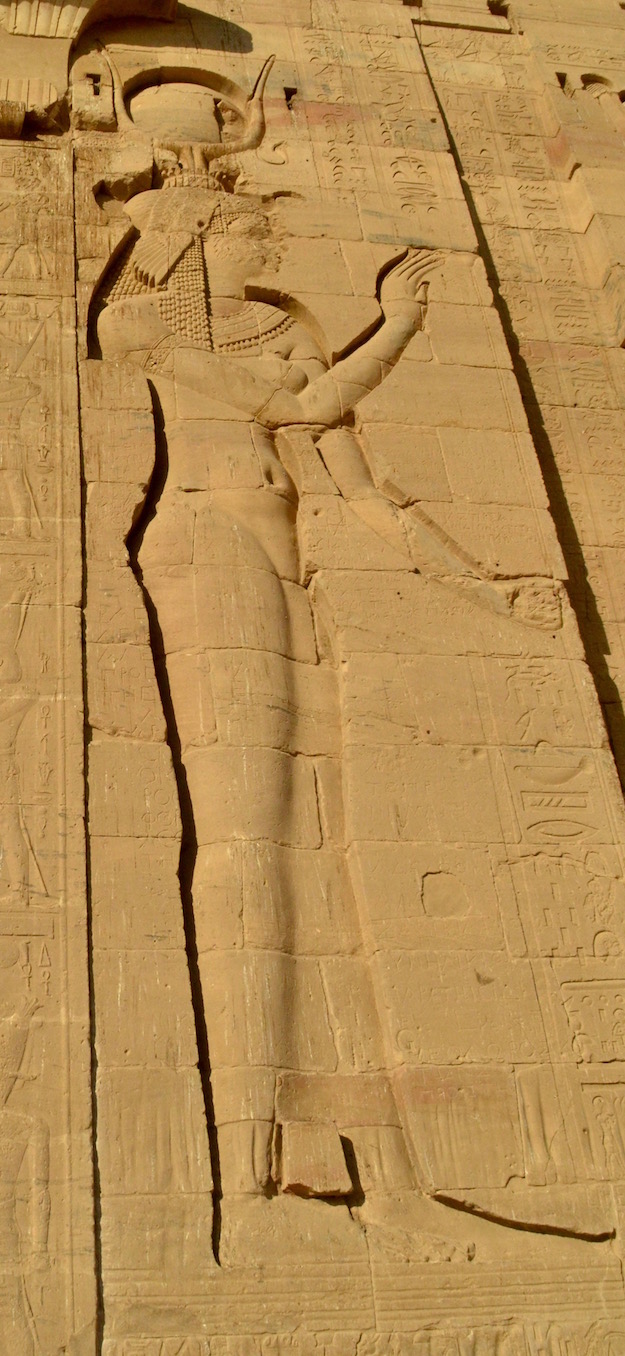 Relief sculpture of the Egyptian goddess Isis.
Relief sculpture of the Egyptian goddess Isis.
And her son Horus, the falcon-headed god wearing the two crowns of Egypt, the white crown of Upper Egypt and the red crown of Lower Egypt. Once Egypt was unified in 3100 B.C. it was usual to depict gods and kings wearing this type of crown.
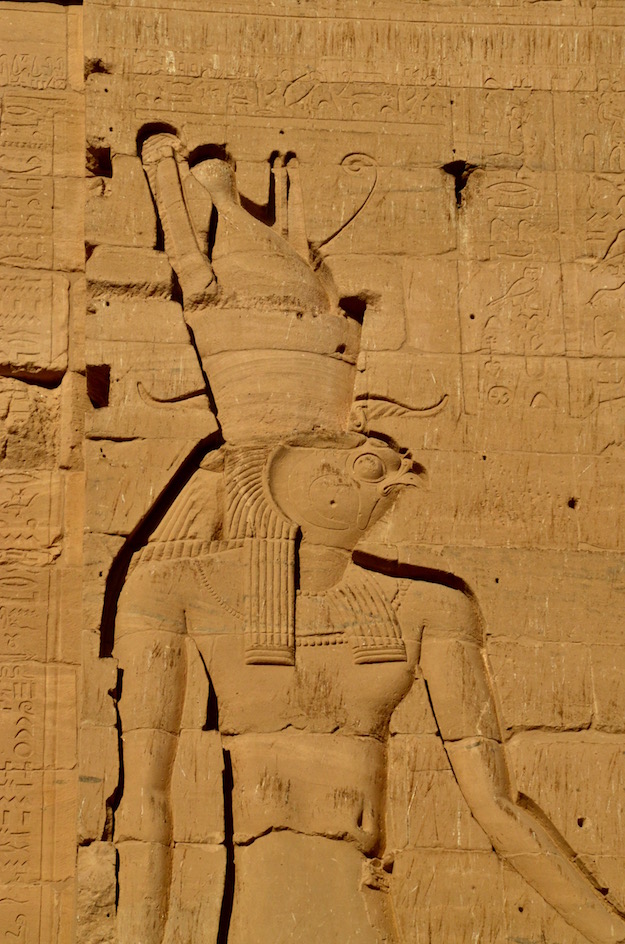 Relief sculpture of the Egyptian god Horus.
Relief sculpture of the Egyptian god Horus.
This is Isis, Horus and Ptolemy III
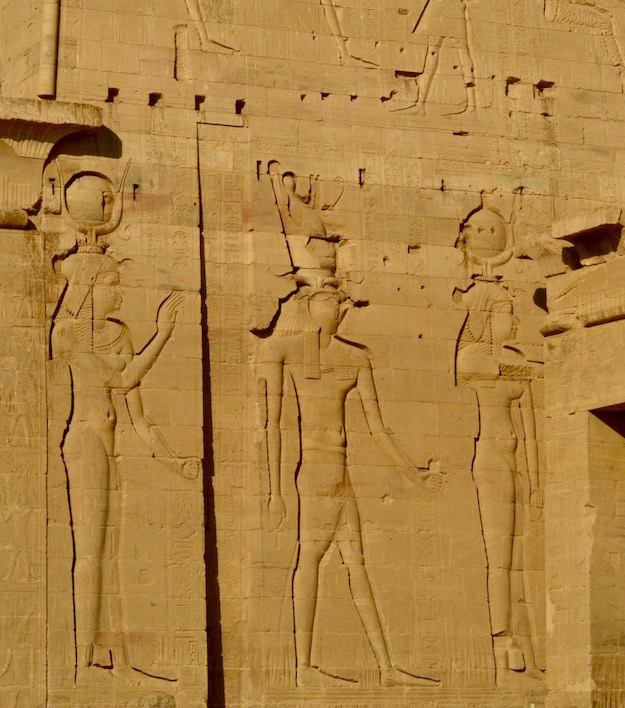 Relief sculptures of Isis, Horus and Ptolemy III (Egyptian King).
Relief sculptures of Isis, Horus and Ptolemy III (Egyptian King).
It is impossible to describe the feeling that comes over one the first time you see these giant depictions in person. Awe, reverence and dumbstruck come to mind, but there is also a tinge of sadness as well. The people who believed in these gods did so for a period of over 4,000 years, before they died and their gods with them, at least figuratively. Will Christianity or Islam have as long a run on the Broadway stage of theism? Who knows, but that brings me to my next topic.
The Philae Temples – Irreverence and Intolerance
As mentioned, much of the construction of the Philae Temples dates from the Roman era and during this time Isis developed a huge following throughout the Roman Empire. Originally persecuted as a cult, it eventually became so mainstream that several Emperors were Isis adherents. The Romans were notoriously blasé about religion, seemingly more into religiosity than actual religious belief and adherence. While they would often start out persecuting a new religion (there were literally hundreds popping up across the empire) they usually accepted it after a while. The Isis and Christian religions followed that pattern. However, once the Christian religion became the official state religion the tolerance for other gods vanished almost over night. The Temple of Isis became the target of what I refer to as religious vandalism. Here is an example.
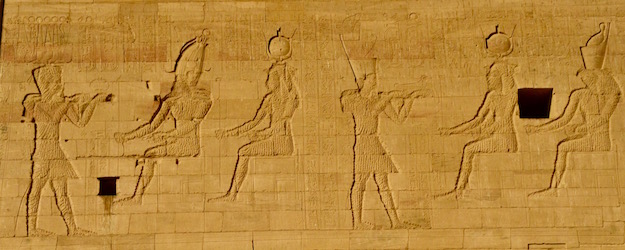 Vandalism of relief sculptures at Philae Temples.
Vandalism of relief sculptures at Philae Temples.
Someone went to great lengths to deface these images of the king paying obeisance to Isis, Horus and Osiris. And this desecration of Isis.
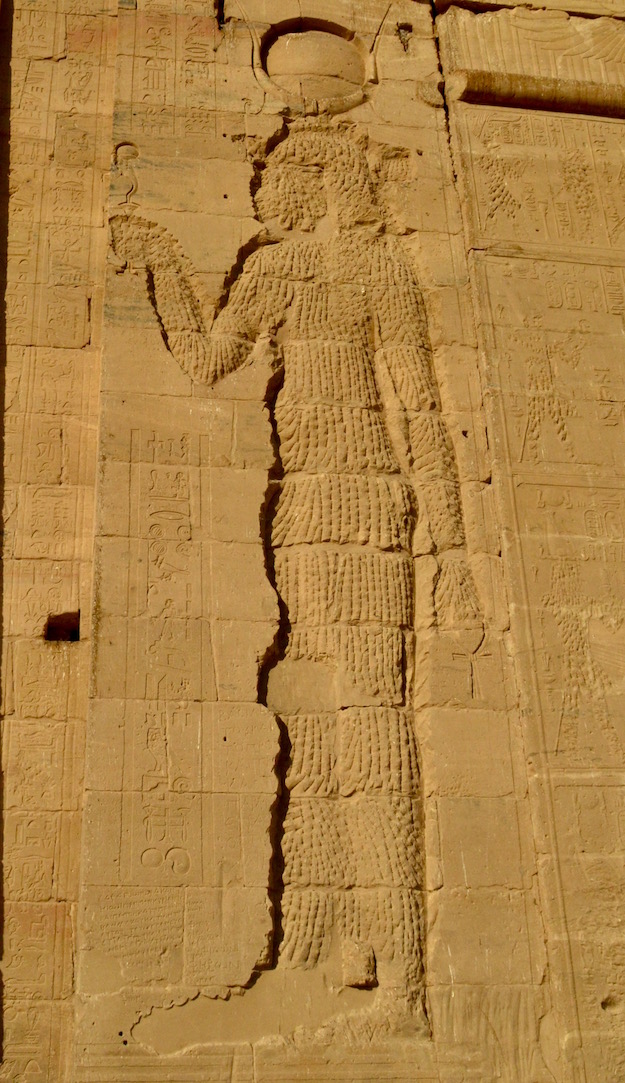 It's unfortunate some people feel the need to vandalize these ancient treasures. In this case, another relief sculpture of Isis.
It's unfortunate some people feel the need to vandalize these ancient treasures. In this case, another relief sculpture of Isis.
If the early Christians really believed that their god was the one and only deity, then they had to also believe that these Egyptians gods were not real and these were just figures cut in stone. So why go to also this trouble – maybe they really weren’t so sure after all. The defacing of the carvings was not limited to the exterior of the temple and was even more extensive inside.
While Christians seem to have gotten over the urge to destroy non-Christian religious images, sadly religious vandalism continues to this day; witness the destruction of the Roman temple at Palmyra, Syria by ISIS. What irony.
The Temple of Isis has also been the subject of less serious vandalism as this picture shows.
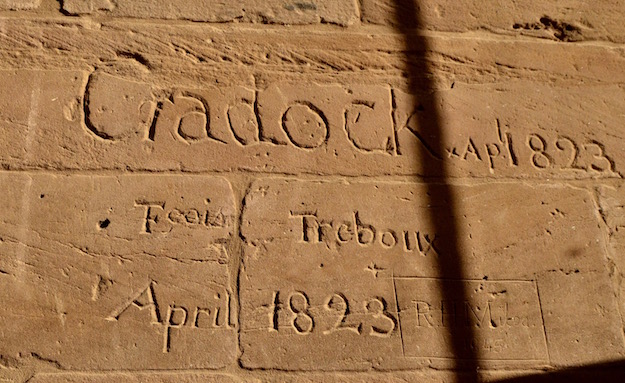 Cradock and Treboux couldn't resist the urge to deface the Temple of Isis.
Cradock and Treboux couldn't resist the urge to deface the Temple of Isis.
But the good news is that the Temple of Isis still stands, greeting visitors every day while Messrs. Cradock and Treboux have long been mouldering in their graves. Would their lives have been less fulfilling if they hadn’t carved their names into the soft sandstone? I doubt it.
Philae Temples Are a Great Place to Study Hieroglyphics
As I mentioned, Ahmed can read hieroglyphics and he chose to use the hieroglyphics inside the Temple of Isis to give us a detailed explanation of what they are and are not. They are not pictographs, which at first glance would appear to be the case. For example, here are representations of a seated woman, scarab beetles, a cow and a baboon, but they do not literally mean those things. It was not until the discovery of the Rosetta Stone in 1799 that contained the same words in Greek, Demotic script (the everyday language of Egyptian scribes) and hieroglyphics that scholars eventually deduced that the hieroglyphic symbols represented phonetic sounds, just like our modern alphabet. It was pretty neat to have Ahmed translate the hieroglyphics into English just as easily as one might translate French to English.
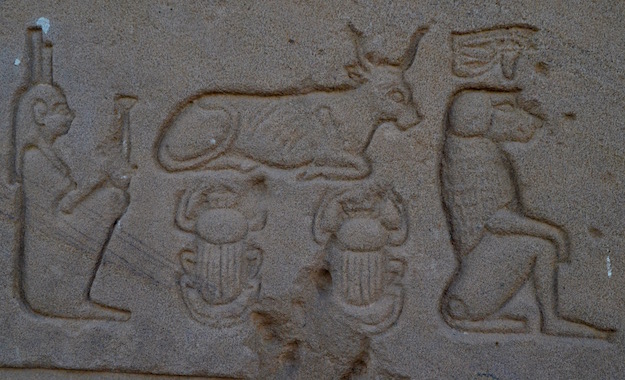
So when you go to an Egyptian temple there are three things to decode. First, the stories told by the carved figures of the gods and kings, secondly the stories told by the paintings on the walls, ceilings and pillars and lastly the hieroglyphics. Ahmed was able to do all three, although sadly, most of the paint is no longer visible. Here’s a good example of a combination of carved figures and hieroglyphics from a photo by Mohammad Fathy. We able to buy a cd with 10,000 images of many of the places we visited for a pretty nominal sum.
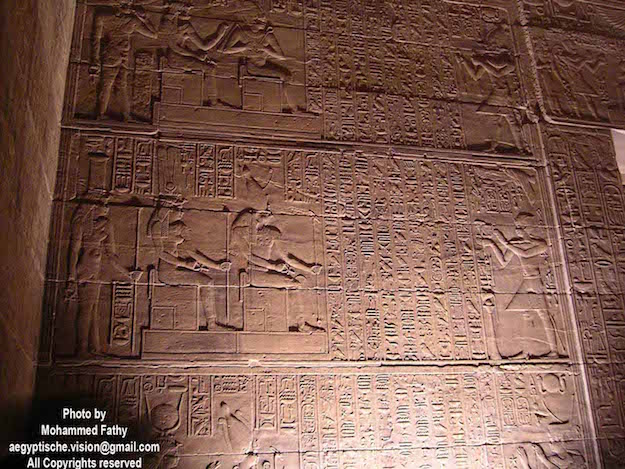 Inside the Temple of Isis the walls are covered in hieroglyphs and carvings.
Inside the Temple of Isis the walls are covered in hieroglyphs and carvings.
The Kiosk of Trajan
Much smaller than the Temple of Isis and with no real interior, the Kiosk of Trajan is nonetheless an imposing building. If any ancient temple might be termed ‘cute’, this would be it. Built by Trajan, one of the truly great Roman emperors, it was one of the very last structures ever built in the Egyptian style and the last to honour the ancient gods Osiris, Horus and Isis.
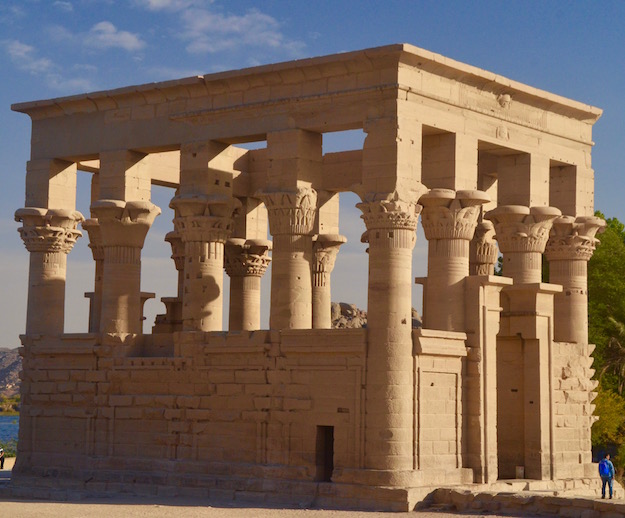 Kiosk of Trajan
Kiosk of Trajan
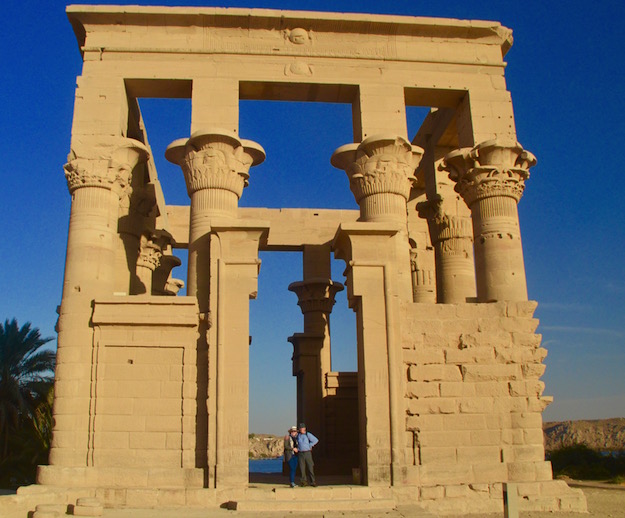 Kiosk of Trajan
Kiosk of Trajan
As we left the Philae Temples we got one last look from the boat at Trajan’s Kiosk which has been inspiring artists for centuries. Now that I’ve seen it myself, I know why.
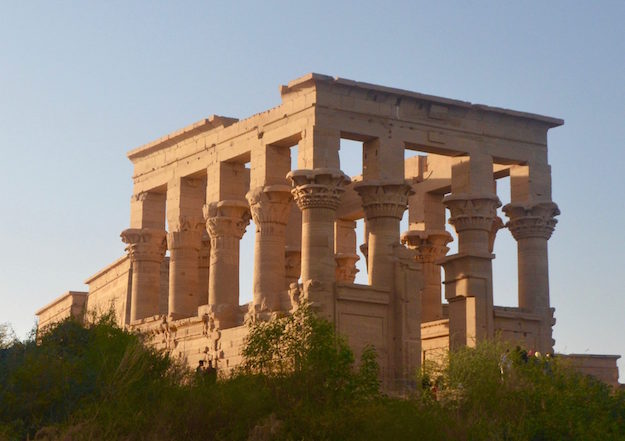 The Kiosk of Trajan, as seen from the Nile River.
The Kiosk of Trajan, as seen from the Nile River.
One final suggestion. Do not even think of combining a trip to the Philae Temples with the all day excursion to Abu Simbel as some tour operators offer. Not only will you be too exhausted to enjoy it, but you will not be giving it the time and respect it deserves. There’s a ton of things to do in and around Aswan as I’ll describe in a future post, so set aside half a day for the great Philae Temples. You won’t regret it.
For more on Dale’s travels to Egypt as well as his other globe-trotting tales – be sure to visit themaritimeexplorer.ca.